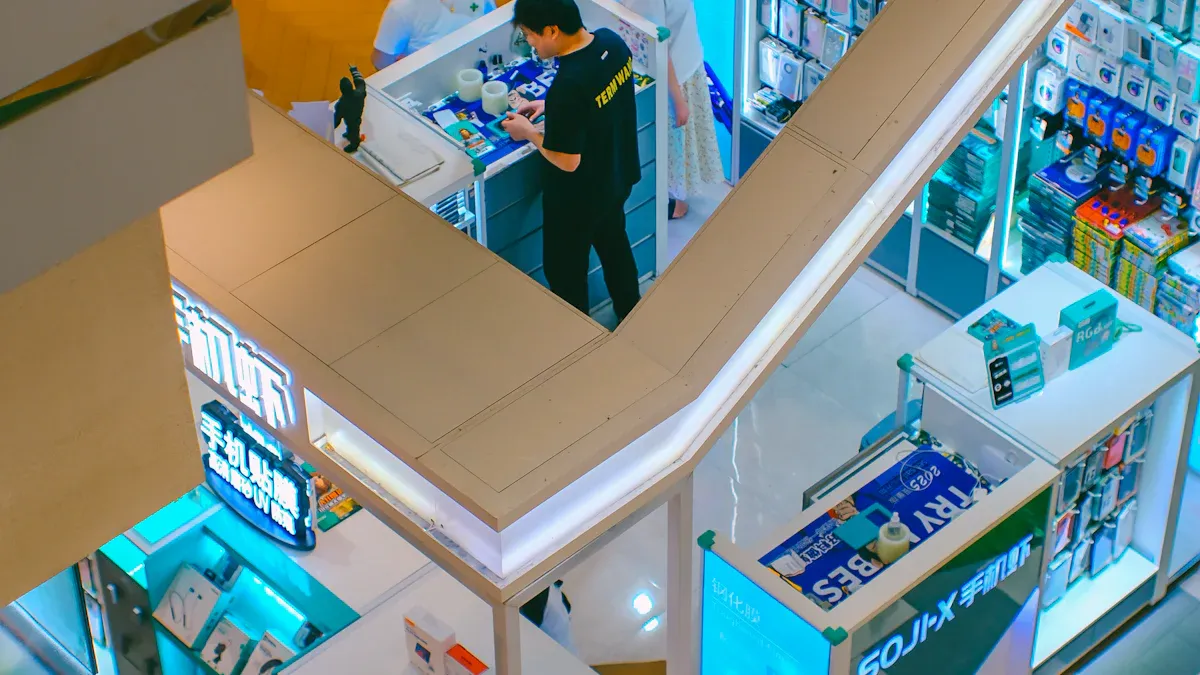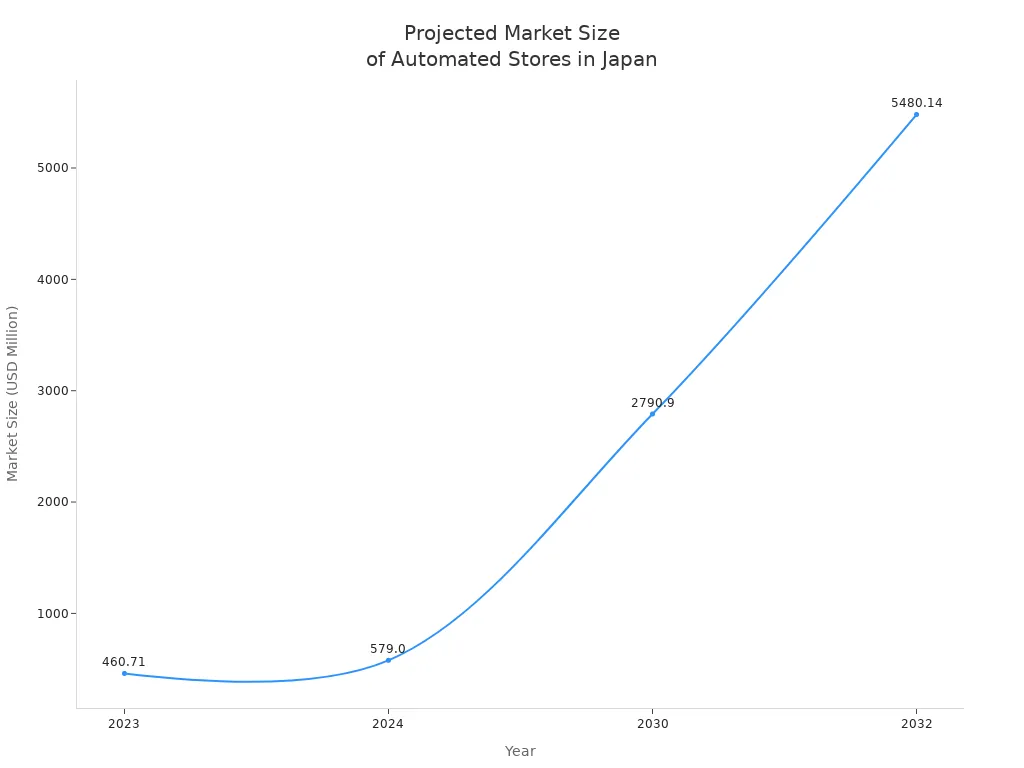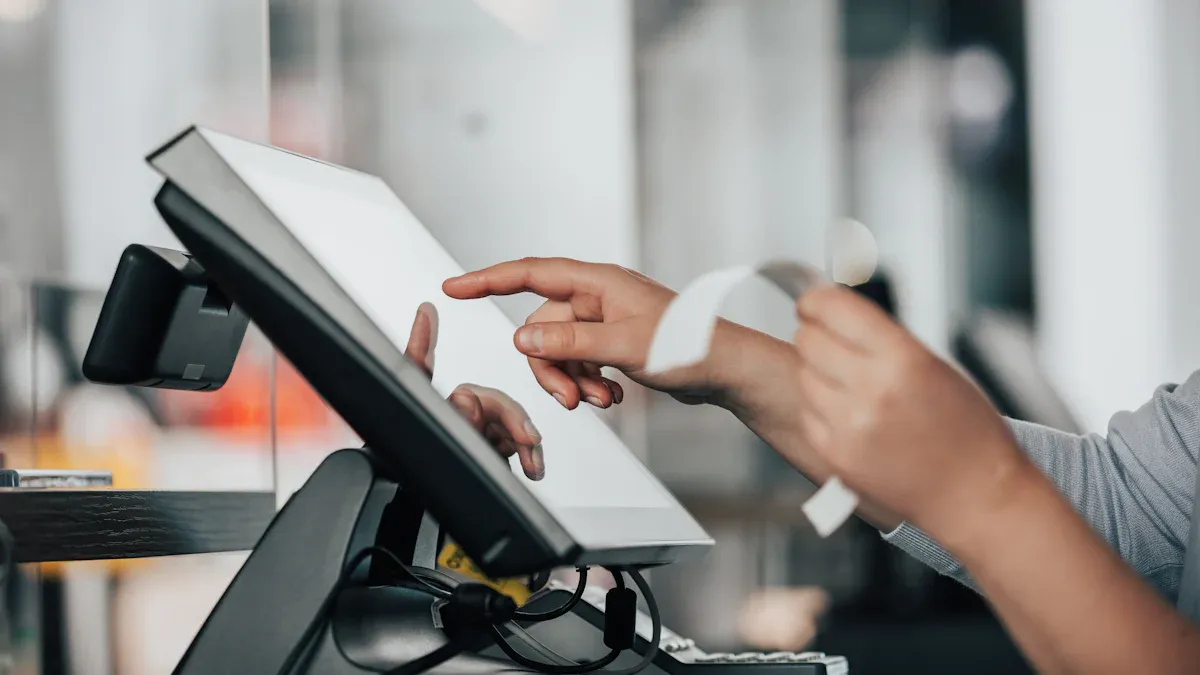The Evolution of Automated Store Technology in Japan’s Unmanned Shops

Japan’s retail world is changing fast because of automated store technology.
The Japan Smart Retail Technology Market was USD 18.3 Billion in 2024.
Experts think the market will reach USD 45.7 Billion by 2033. It will grow at a rate of 10.5% each year from 2026 to 2033.
Factor | Explanation |
|---|---|
Labor Shortages | Automation lowers costs and makes stores work better. This helps stores compete. |
People want shopping to be fast and easy. They like contactless ways to buy things. | |
Aging Population | Stores make special plans for older shoppers. |
Health and Safety Concerns | Many people want safe stores after the pandemic. They like stores that run by themselves. |
Technology Integration | AI helps stores show ads that fit each shopper. It also helps stores keep track of products. |
Key Takeaways
Automated store technology in Japan is growing fast. It may reach USD 45.7 billion by 2033. This makes shopping easier and quicker for people.
AI and robotics make shopping better for customers. They help people check out fast and get shopping made just for them. Customers can take items and leave without waiting in line.
Unmanned stores help shops save money on workers. Automation makes stores work better by 20.8%. Stores can stay open for more hours.
Security and privacy are important for unmanned stores. Strong systems and clear messages help shoppers feel safe and trust the store.
Shopping in Japan will use more advanced technology soon. This will make shopping even faster and easier for everyone.
Evolution of Automated Store Technology
Early Milestones
Japan began using unmanned shops a long time ago. The first ones were in the countryside. Farmers made small stalls called unmanned sales. These stalls used an honor system. Shoppers took goods and left money in a box. People trusted each other in these shops.
Type of Store | Description | Technology Used |
|---|---|---|
unmanned sales | Small stalls in rural areas that use trust. | Community trust system |
Cities started to grow bigger. Retailers began using better systems. Vending machines became common in the 1970s and 1980s. People could buy drinks and snacks any time. These machines did not need workers. This idea helped automated store technology grow in Japan.
The market for automated store technology grew fast. In 2023, it was about 460 million US dollars. By 2030, experts think it will be almost 2.8 billion US dollars. The market keeps growing, showing people like these stores.
Year | Projected Market Size (USD) | CAGR (%) |
|---|---|---|
2023 | 460.71M | 31.66 |
2024 | 579.0M | 29.3 |
2030 | 2,790.9M | |
2032 | 5,480.14M |

Recent Trends
Japan now has many new unmanned shops. Companies use advanced technology to make shopping easy and quick. Lawson, a big store chain, worked with CloudPick to open smart stores. These stores use cameras and sensors to see what shoppers take. Customers walk in, pick up things, and leave without waiting.
Robot Mart is another store. It uses robots to help people find products. Osaka Electrocommunication University has a smart store that tries new ideas. It uses facial recognition payments and automatic restocking.
Stores now use artificial intelligence and machine learning. These help manage products and study what customers do. Stores also use RFID and IoT systems to track items and collect data. Some shops let people pay with their faces or fingerprints. This makes shopping faster and safer.
Aspect | Description |
|---|---|
AI & ML | Used for managing products and studying customers. |
RFID and IoT | Used for tracking items and collecting data. |
Recognition and Biometric Payment | Lets people pay with faces or fingerprints for safety and speed. |
Stores save money by spending less on workers.
Many unmanned stores are open all day and night.
Customers get faster checkout and a more personal experience.
Japan has more unmanned stores now than before. But growth has slowed down lately. Some stores have problems with security and privacy. Some shoppers still like regular stores with workers. Stores now try to make shopping safer and build trust.
Note: Strong security systems and good data protection help keep unmanned stores safe.
Automated store technology keeps changing how people shop in Japan. Stores test new ideas to make shopping safer, smarter, and easier.
Technologies Driving Unmanned Stores

Artificial Intelligence
Artificial intelligence is very important in unmanned stores. AI sensors check the temperature and humidity in stores with fresh food. This helps stop food from going bad. The lights and sounds change when more or fewer people are inside. This saves energy for the store. Cameras on the ceiling and sensors on shelves watch what customers pick up. When people leave, the system charges them by itself. FamilyMart and Lawson use AI to help customers and make work easier. AI also helps keep the store safe by finding problems fast. Deep learning lets stores find fraud and watch what happens. Access control only lets registered people enter, so stores stay safe. AI looks at how customers move to make the store better and show popular items. Shoppers see special deals based on what they do, and they get help right away if they need it.
AI helps with safety and finding fraud.
Special deals and quick help make shopping better.
IoT Systems
IoT systems link devices and sensors to help stores work well. These systems watch the stock and keep shelves full. RFID tags and AI cameras work together to make checkout faster and keep products ready. Robots like TX SCARA and Model T fill shelves and help with stock. Stores use these tools to cut wait times and keep track of items.
Functionality | Impact on Inventory Management and Customer Experience | |
|---|---|---|
AI Cameras | Make stores safer and help with payments | Safe shopping and fast checkout |
RFID | Quick checkout and good tracking | Less waiting and better stock control |
Robots | Fill shelves and handle stock | Products stay on shelves and stores work better |
Robotics Integration
Robotics help make shopping simple and fast. Unmanned stores use delivery robots to bring things to people’s homes. These robots have cameras and are watched from far away. Stores also use screens for customer service and AI self-checkout.
In Japan, unmanned stores use many kinds of robots. Delivery robots bring goods to people’s homes. These robots have many cameras and are watched from a distance. There are also customer service screens and AI self-checkout to help shoppers.
Cashless Payments
Cashless payments make shopping smooth and easy. QR payments are common in ramen shops and markets where cash is hard to use. PayPay has 60 million users, so many people like QR code payments. Shoppers want stores to have no-touch delivery and self-checkout. Touchless shopping is normal now, so shopping is faster and safer. The market for unmanned checkout is growing fast. Convenience stores use AI kiosks to help many shoppers and save money on workers.
Shoppers want no-touch delivery and self-checkout.
AI kiosks make checkout fast and save money.
Automated store technology uses AI, IoT, robotics, and cashless payments. These smart stores make shopping easy, safe, and quick. They help stores give customers what they want and work better.
Unmanned Store Formats in Japan

Convenience Stores
Convenience stores in Japan use automated store technology now. Big chains like FamilyMart and Lawson have self-checkout machines. They also use cameras with AI. Customers walk in and pick up what they want. They do not need to wait in line. Lawson’s stores use sensors and cameras to track items. NewDays has stores with only cashless self-checkout. Staff just restock and clean. Seven-Eleven tests stores with AI monitoring all day. Staff are on call if needed. These changes help stores stay open longer. Stores can serve more people with fewer workers. Automation started because Japan has fewer working-age people. Stores need new ways to keep working well.
Roadside Shops
Roadside shops in Japan use vending machines as small stores. These machines sell snacks, drinks, and toiletries. Some even sell expensive gadgets. Some vending machines hold up to 300 items. Special machines sell fresh eggs, ramen, and cigarettes. People find vending machines everywhere. They are in busy cities and quiet country roads. The many products show Japanese retailers are creative. These shops work well where it is hard to hire staff. They help keep stores open in many places.
Food Shops and Honor System
Some food shops in Japan use the honor system. Farmers and small business owners set up stalls called unmanned sales. Shoppers take goods and leave money in a box. In cities, some unmanned meat shops sell special products. They offer Kagoshima Black Wagyu Beef and Hamburg steaks. Customers self-report what they buy instead of using barcodes. People can pay with cash, credit, or e-money. This system needs trust and respect. These are important in Japanese culture. The honor system is not like most modern stores. But it still works well in many places.
Note: Unmanned store formats in Japan show how culture and technology work together. Each format helps local people and uses new ideas to fix old problems.
Benefits for Retailers and Shoppers
Efficiency and Cost Savings
Japanese retailers notice big changes after using automated store technology. Stores can now automate about 70% of their daily work. This helps stores save money because paying workers costs a lot. With fewer workers, stores spend less and work better. The table below shows how much stores have gotten better:
Metric | Percentage |
|---|---|
Reduction in operations | |
Increase in additional revenue | 13.9% |
Gain in efficiency | 20.8% |
Labor costs can be half or more of a store’s budget.
Stores see a 14.8% drop in operations and a 20.8% rise in efficiency.
These changes let stores stay open longer and help more people, even when there are not enough workers.
Customer Convenience
Unmanned stores make shopping much easier for everyone. Shoppers walk in, grab what they want, and leave without waiting. AI and 3D cameras watch what each person buys, so checkout is quick and easy. This works well in busy cities and places where regular stores are hard to open. People can shop fast, even late at night or early in the morning.
Tip: Many people like the grab-and-go style because it saves time and fits busy lives.
Personalization
Unmanned stores in Japan use smart technology to make shopping feel special. AI systems talk with customers, help them find things, and suggest items they might like. The table below shows features that make each visit better:
Feature | Benefit |
|---|---|
Self-Service Technology | |
AI and Automation | Personal service and better stock |
Contactless Payments | Safe and fast payments |
Data Analytics for Personalization | Custom tips for each shopper |
24/7 Accessibility | Shop any time |
Convenience | Easy grab-and-go shopping |
AI matches customer questions with the right products. This helps shoppers find what they want faster and makes each visit nicer.
Challenges and Barriers
Security Issues
Unmanned stores in Japan have many security problems. Theft and vandalism are big worries. Store owners use special cameras and AI to watch for trouble. Cameras follow everyone inside the store. AI can find strange actions and warn workers. These tools help stop crime, but some danger remains.
Security Challenges | Solutions Implemented |
|---|---|
Theft | Special cameras and AI help stop stealing |
Vandalism | Steps are taken to deal with vandalism |
Note: Good security tools keep products safe and protect everyone.
Privacy Concerns
Unmanned stores collect a lot of data. Cameras and sensors watch what shoppers do. Some people worry about how stores use this data. They want to know if their faces or fingerprints are safe. Store owners must follow strict privacy rules. They use encryption and only let some people see the data. Signs tell shoppers about the data being collected.
Stores use encryption to keep data safe.
Signs show how stores use and collect information.
Adoption and Trust
Many people like unmanned stores, but some feel unsure. Shoppers want to trust the new technology. They worry about mistakes at checkout or payment problems. Store owners try to build trust with shoppers. They give help and fix problems fast. Some stores let shoppers talk to staff on video calls. This makes people feel safe and cared for.
Tip: Good help and clear signs make shoppers trust unmanned stores.
Regulatory Factors
Japan has strict rules for unmanned stores. The government checks if stores follow safety and privacy laws. Store owners must update systems to follow new rules. These rules keep shoppers safe and stores working well. Sometimes, new laws make it harder to open stores. Owners must spend money to update technology and train workers.
Rules keep shoppers safe and help stores run well.
New rules can slow down new store openings.
Unmanned stores in Japan have many problems to solve. Security, privacy, trust, and rules all affect how these stores grow. Store owners must fix these issues to keep unmanned shops safe and liked by shoppers.
Future Outlook
Emerging Innovations
Japan’s retail world keeps trying new automated store ideas. Stores now have self-checkout kiosks and mobile payments. These tools help people shop faster and need fewer workers. Automated inventory systems use IoT devices to watch products and refill shelves. Stores get real-time data to help managers make good choices. In early 2024, 7-Eleven shared plans for new unmanned convenience stores. These stores work without staff. FamilyMart started a mobile shop at the Osaka Expo. It has self-checkout features. These changes show stores want more automation.
People in Japan like AI-driven services. Many enjoy getting special offers and talking with smart systems. Retailers know customer acceptance is key for success. In the future, stores may use advanced technology for every shopping step.
Note: The next unmanned stores may use technology for everything, from checkout to inventory.
Impact on Retail
AI-powered stores are changing shopping in Japan. Retailers use computer vision and deep learning to make shopping easy. Customers do not wait in lines or talk to cashiers. Stores like the one at Naka-Mosorui Station show AI can make customers happier. These changes help stores work better and serve more people.
Japan has fewer workers because many people are older. Automated stores help fix this problem. Young shoppers want high-tech ways to shop, so stores use AI and robotics. Experts think unmanned convenience stores will grow by 7.1% from 2025 to 2032. More people in cities and new technology help this growth. Big companies invest in AI, IoT, and robotics to make stores better.
Factor | Expected Impact on Retail |
|---|---|
AI Integration | Faster shopping, better service |
IoT and Robotics | Improved inventory, less staff |
Market Growth | More unmanned stores in cities |
Retailers in Japan keep spending money on automated store technology. These new ideas promise a future with smooth stores and happier shoppers.
Japan’s retail world is changing fast because of automated store technology.
Retailers use AI to help with checkout and inventory. They also use it for customer service.
Cashierless stores make checkout much faster. They can cut the time by almost 95%.
AI forecasting lets stores plan what to sell more quickly.
Country | Challenges | |
|---|---|---|
Japan | Strong technology and a good culture | Not enough workers |
China | Grows fast and has many shoppers | Rules are strict |
United States | Has great tech and many markets | Lots of competition |
Unmanned stores make shopping easier and safer. Shoppers like paying without touching anything. They want fast service. As technology gets better, stores will keep changing to fit what people need.
FAQ
What is an unmanned store?
An unmanned store works without staff. Technology helps the store run. Cameras and sensors help shoppers find things. Robots help people shop. Customers pay using cashless systems. These stores stay open all day and night.
How do unmanned stores prevent theft?
Store owners use AI cameras to watch for theft. Sensors help spot people trying to steal. Security systems warn staff if there is trouble. Access control helps keep products safe.
Are unmanned stores safe for personal data?
Most unmanned stores use encryption to protect data. They follow privacy rules to keep information safe. Stores put up signs to explain how they use data. Shoppers can ask questions about data safety.
What types of payments do unmanned stores accept?
Payment Type | Description |
|---|---|
QR Code | Scan with your phone |
Credit Card | Tap or put in your card |
E-Money | Use prepaid cards |
Biometric | Use your face or finger |
Why are unmanned stores popular in Japan?
People in Japan want shopping to be quick and easy. Unmanned stores help because there are not enough workers. These stores make shopping simple for everyone. Technology gives shoppers more convenience.
See Also
The Future of Retail Lies in AI-Driven Stores
Comparing Micromarkets and Smart Stores in Global Retail
The Transformation Journey of Self-Checkout Systems
Smart Technology in Electronics Vending Machines Reshapes Retail
